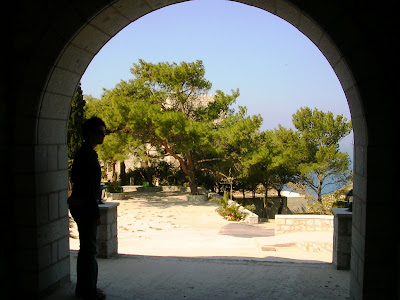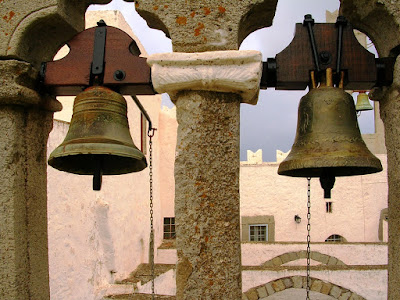First, let me mention that Rob’s video of the Resurrection service at the Monastery of the Annunciation on Great Saturday night is now available here.
I also forgot to mention before that we were very blessed to venerate there the relics of the modern-day saint, Fr Amphilochios Makris (+1970), who founded the monastery. Although not technically a saint yet, his icon adorns the far right-hand side of the iconostasis and some of his relics are underneath it for veneration. In the minds of the nuns and the people of Patmos, therefore, he is a saint (much like Elder Paisios is here in northern Greece). A short version of his life is available in the great book “Precious Vessels of the Holy Spirit,” by Herman Middleton, a former student here in Thessaloniki.
Anyway, back to Rob’s videos. They are all available here, along the right-hand side of the page. Videos for the rest of the trip (days 5 and 6) should be added there within the next couple days.
All our photos of the trip are available here and all Brendan's photos are available here.
On a technical note, is anyone having problems viewing the photos on some of the recent posts on here? For me, they seem to randomly disappear, leaving only these little placeholder boxes, and then reappear later. Please let me know if you’re noticing this as well, and especially let me know if you know why it’s doing that…
Finally, our Paschal Monday. Again, we had beautiful weather and we decided to soak up as much of the island as we could before our ferry headed out at 1:30 PM. First, we visited a little chapel near the Monastery of St John called Panagia E Diasozoussa (the One Who Rescues). In it, we venerated one of only five surviving icons of the Panagia painted by St Luke the Evangelist. I was even allowed to take a photo (without flash, of course, which made it a little blurry).
A monk at the monastery told us that most of the 70 icons painted by St Luke (of which, again, only 5 survive) were painted from memory. But this one of the Panagia was actually painted in person. However, because of his modesty and her great holiness, he painted it from her reflection in a pool of water.
Afterwards, we took one last ride on the moped and visited the little village of Petra, which features an enormous rock on the beach. We parked and climbed to the top, which had some magnificent views.
We then returned to the house, collected our things, and headed to the port with everyone. As usual with the Greeks, we had to herd ourselves into this small space and wait for the boat. Then, as soon as someone opened the gate, everyone tramples each other to be the first to get into the boat, where we then sit and wait for it to leave on its seven-hour ride.
One woman was so eager to get on to the boat first that she actually dropped her suitcase over the fence and then, when the port police weren’t looking, leapt over, grabbed her luggage, and bolted for the boat. She hopped on the vehicle ramp just as it was lowering to the ground. All this for a good seat!
As for us, we managed to push our way far enough front to grab a few seats shoehorned into a restaurant lounge. The boat was actually on time, so we had an opportunity to go into Athens and get a gyro before getting on the night train at 11:45 PM. This was my first experience with the night train and I have to say this is the way to go! Of course, it’s extremely crowded, but I think we all slept the whole way.
Someone is supposed to wake you up when you reach your destination, but of course they didn’t, so Rob woke up in a startle around 6 AM to find us in Thessaloniki and the train deserted (since people push and shove to get off, we were probably only there 10 minutes). As we got our things together, finally the conductor came by and told us he was pulling out in two minutes! We grabbed everything and hopped off. We finished putting on our shoes on the train platform and, voila, we were home! It was a wonderful, unforgettable trip!











































